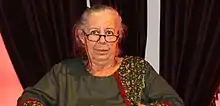Tomris Bakır | |
|---|---|
 | |
| Born | Tomris Akbaşoğlu 5 November 1941 |
| Died | 25 February 2020 (aged 78) |
| Citizenship | Turkey |
| Occupation | Archaeologist |
| Known for | Director of Excavations at Daskyleion |
| Academic background | |
| Alma mater | Heidelberg University |
| Thesis | Der Kolonnettenkrater in Korinth und Attika (1974) |
| Doctoral advisor | Roland Hampe |
| Academic work | |
| Discipline | Classical archaeology |
Tomris Bakır (5 November 1941 - 25 February 2020) was a classical archaeologist from Turkey, who specialised in ceramics, and was the Director of Excavations at Daskyleion.
Biography
Tomris Akbaşoğlu was born on 5 November 1941.[1] She studied at Ankara University, where she obtained her undergraduate degree.[2] She was awarded a doctoral degree at the Archaeological Institute of Heidelberg University, doctoral advisor was Roland Hampe.[3] She was married to the archaeologist Güven Bakır (de).[4]
From 1977, after returning to Turkey, Bakır taught as Assistant Professor at Ataturk University in Erzurum.[2] In 1988 she was appointed Professor at Ege University in Izmir, where she worked until her retirement in 2010.[2] From 1988 to 2010 she was the Director of the Excavations in Daskyleion.[5] In particular, Bakır's excavations focused on the residence of the Persian satrap at the site.[6] During her time running excavations at the site, a building interpreted as a Zoroastrian temple was excavated.[7] Significant finds that were excavated from other site contexts under her directorship, included: two seals and one bulla;[8] imported amphoras;[9] as well as many sherds of pottery.[7] She was instrumental in the foundation of Bandırma Archaeology Museum in 2003.[5] In addition, she was an internationally respected researcher: she was a member of the German Archaeological Institute (DAI), as well as other organisations.[5]
Bakır died on 25 February 2020 and her body was interred at Yakaköy Cemetery on 26 February, following prayer at Güven Mosque.[5][2]
Reception
Bakır's work on Corinthian column-kraters, Der Kolonnettenkrater in Korinth und Attika, was described as a "methodical and painstaking examination" of the pottery.[10] At her death, the Turkish Ministry of Culture and Tourism described her as an "esteemed teacher, who introduced Daskyleion Ancient City to the world [and] opened new horizons in Turkish Archaeology".[11]
Selected publications
- Der Kolonnettenkrater in Korinth und Attika zwischen 625 und 550 v. Chr (Triltsch, Würzburg 1974).[12]
- Korinth seramiğinde aslan figürünün gelişimi (Ege Üniversitesi Sosyal Bilimler Fakültesi, Izmir 1982).[13]
- 'Archäologische Beobachtungen über die Residenz in Daskyleion', Pallas. Revue d’études antiques (1995).[14]
- Herausgeberin mit Heleen Sancisi-Weerdenburg: Achaemenid Anatolia. Proceedings of the First International Symposium on Anatolia in the Achaemenid Period, Bandirma, 15–18 August 1997 (Nederlands Instituut voor het Nabije Oosten, Leiden 2001).[15]
- Daskyleion (Balıkesir Valiliği, Balıkesir 2011).[16]
References
- ↑ Totentafel in Türk Eskiçağ Bilimleri Enstitüsü Haberler 45, 2019/20 (Digitalisat).
- 1 2 3 4 "Prof. Dr. Tomris Bakır vefat etti haberi". Arkeolojik Haber. Retrieved 2020-12-22.
- ↑ Duvar, Gazete (2020-02-26). "Arkeolog Tomris Bakır vefat etti". Gazete Duvar (in Turkish). Retrieved 2020-12-22.
- ↑ "Arkeolog Profesör Doktor Güven Bakır vefat etti haberi". Arkeolojik Haber. Retrieved 2020-12-22.
- 1 2 3 4 "Prof. Dr. Tomris Bakır´ı kaybettik". yenierdekgazetesi.com. Retrieved 2020-12-22.
- ↑ Marek, Christian; Frei, Peter (2016-06-21). In the Land of a Thousand Gods: A History of Asia Minor in the Ancient World. Princeton University Press. p. 36. ISBN 978-0-691-15979-9.
- 1 2 Nunn, Astrid (2016-07-15). "Tomris Bakir. Dascylium (547-334 B.C.)". Abstracta Iranica (in French) (Volume 34-35-36). doi:10.4000/abstractairanica.41676. ISSN 0240-8910.
- ↑ Brelaz, Cédric (2007). "Des balles de fronde à Daskyleion : armes de guerre ou armes de chasse ?". Anatolia Antiqua. Eski Anadolu. 15 (1): 71–82. doi:10.3406/anata.2007.1225.
- ↑ Yaldır, Aylin Koçak (2011-09-01). "Imported trade amphoras in Daskyleion from the seventh and sixth centuries bc and the Hellespontine-Phyrygia route". World Archaeology. 43 (3): 364–379. doi:10.1080/00438243.2011.607610. ISSN 0043-8243. S2CID 219611603.
- ↑ Cook, R. M. (1977). "Tomris Bakir: Der Kolonnettenkrater in Korinth und Attika zwiscben 625 und 550 v. Chr. (Beiträge zur Archäologie 7.) Pp. 81; 16 plates. Würzburg: Konrad Triltsch Verlag, 1974. Paper". The Classical Review. 27 (1): 139. doi:10.1017/S0009840X00223226. ISSN 0009-840X. S2CID 161746370.
- ↑ "Vefat Haberi". kvmgm.ktb.gov.tr. Retrieved 2020-12-22.
- ↑ Bakır, Tomris (1974). Der Kolonnettenkrater in Korinth und Attika zwischen 625 und 550 v. Chr (in German). K. Triltsch.
- ↑ Bakır, Tomris (1982). Korinth seramiğinde aslan figürünün gelişimi (in Turkish). Ticaret Matbaacılık.
- ↑ Bakir, Tomris (1995). "Archäologische Beobachtungen über die Residenz in Daskyleion". Pallas. Revue d'études antiques. 43 (1): 269–285. doi:10.3406/palla.1995.1374.
- ↑ Achaemenid Anatolia : proceedings of the First International Symposium on Anatolia in the Achaemenid Period, Bandirma 15-18 August 1997. Bakır, Tomris., Sancisi-Weerdenburg, Heleen. Leiden: Nederlands Instituut voor het Nabije Oosten. 2001. ISBN 90-6258-093-9. OCLC 49359945.
{{cite book}}: CS1 maint: others (link) - ↑ Bakır, Tomris. (2011). Daskyleion : Balıkesir'in eski çağlardaki valilik merkezi. Balıkesir: Balıkesir Valiliği. ISBN 978-605-359-461-1. OCLC 777769316.
External links
- Prof.Dr.Tomris BAKIR - DASKYLEİON